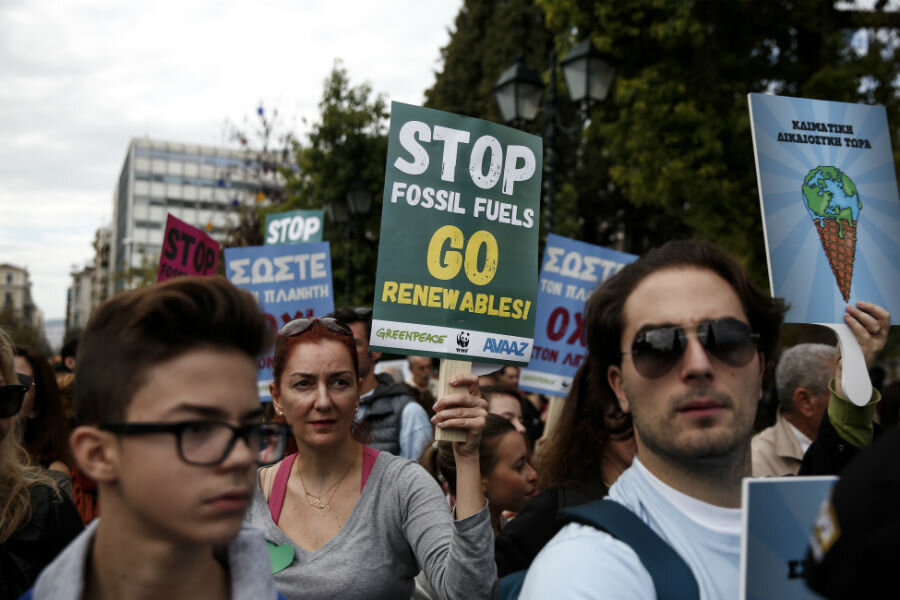Climate protests: Is the public more engaged than ever?
Loading...
On the weekend leading up to the UN COP 21 World Climate Summit in Paris, hundreds of thousands of people around the world took to the streets to march and demand bold action on climate change.
The Global Climate March counted more than 2,100 events happening in cities including Sydney, Berlin, London, São Paulo, and New York – a level of participation the organizers say makes it one of the biggest climate change actions ever.
Makassar, a coastal city in eastern Indonesia, held the first climate march in its history over the weekend. Elementary school children took part in the march put together by Earth Hour Makassar and other community groups. Signs were held aloft calling attention to the prevalence of forest fires, coral bleaching, and reliance on coal, The Guardian reports.
In Paris, at the Place de la République, organizers estimate more than 11,000 pairs of shoes – including a pair given by the pope – were donated and arranged to symbolize the activists who could not participate due to the ban on large gatherings in Paris following the November 13 terror attacks in the city that killed 130. Activists in Paris have come up with a new plan that they say cooperates with tighter security: a human chain of about 3,400 people linking arms along a planned 1.9 mile route through central Paris, from the Place de la République to Place de la Nation.
Alix Mazounie of French Climate Action Network said the activists figured that a human chain would not violate the state of emergency in place in Paris. "This is not civil disobedience," she told Reuters. The chain would break, for example, wherever it crosses a road to avoid disrupting traffic.
In Australia, organizer Reece Proudfoot said 130,000 people participated in rallies, according to Sydney Morning Herald. Sydney's mayor tweeted that 45,000 people attended the city's march, the largest in the city's history, NBC News reported. Protesters held posters reading: “There is no Planet B,” and “Say no to burning national forests for electricity”.
"This is going to send a message to the government that Australia must do more to combat climate change, that the targets we are taking to the Paris conference are too low," Mr. Proudfoot told the Herald.
On Saturday, faith-based groups delivered a collection of petitions with 1.8 million signatures urging bolder action, collected on pilgrimages to Paris. "The time for talking is long over," said Yeb Saño of the Philippines, who walked more than 900 miles, carrying the petitions from Rome to the French capital.
Many environmental activists are calling for fossil fuels to be phased out entirely, and a shift to 100 percent renewable energies by 2050, Reuters reports.
As The Christian Science Monitor reported, for the first time, almost all nations are putting forth plans for some level of action on climate change.
On the question of participation, this erodes the historical divide between developed and developing countries. To get there, however, negotiators jettisoned specific greenhouse-gas emissions targets imposed in a binding treaty. Those targets have been replaced by an overall goal countries have accepted: to hold global warming to no more than 2 degrees Celsius (3.6 degrees Fahrenheit) by 2100. Each country determines how much it can contribute to curbing emissions – mainly through cuts or a reduction in the growth rate of emissions – that collectively put the world on the 2-degree path.
The talks in Paris are a rare global moment that addresses a problem keenly felt by activists of climate change around the world: “urgency is not felt by many people,” said Marshall Ganz, a senior lecturer at Harvard Kennedy School, and a leading academic on social action, which results in a low-level of participation in climate change activism.
“How to make that cosmic sense of urgency immediately felt is one of the challenges of this [climate] movement,” Dr. Ganz said in a 2013 interview with Harvard University Center for the Environment.
One of Ganz's lessons, according to the report by Harvard University, is "that moral urgency – a sense of injustice, or even anger – is often needed to move individuals to act. This is often accompanied by hope, or the sense of the plausible, the possible. Action of this kind may produce change in the participants themselves, as well as in the world around them."
COP21 appears to be an event that provides would-be activists with the ability to hope, and ask, for robust change. It also seems to be driving citizens to the street – in numbers never before seen.








